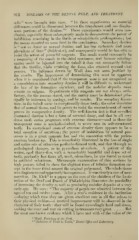Page 902 - My FlipBook
P. 902
912 DISEASES OF THE DENTAL PULP, AND TREATMENT.
cells " were brought into view. " In these experiments no essential
dilferences could be discovered between the translucent and less diapha-
nous portions of the dentine." ^ These experiments would seem con-
clusive, especially those subsequently made to demonstrate the power of
imbibition remaining in the fibrils or odontoblastic prolongations ; but
the means resorted to seem fatal to the conclusions. Secondary dentine
" not as dense as normal dentine and has less carbonate and more
is
])hosphate of lime " (Sehlenker), and consequently would be less able to
resist the action of powerful reagents. The result would necessarily be
a reopening of the canals in the dried specimens, and because coloring-
matter could be injected into the tubuli it does not necessarily follow
that the tibrilltie, while retaining the form, also retained normal vital
powers. The inference drawn by Wedl does not seem justified by
the results. The importance of determining this must be apparent
when it is considered that if the transparent zone is not recognized as
a consolidation into secondary dentine it will be difficult to understand
the law of its formation anywhere, and the nodular deposits must
remain an enigma. Experiments with reagents are not always satis-
factory, for the reasons stated, and the matter must be determined prin-
cipally by inference, by analogy, and by results. The secondary forma-
tions in the tubuli occur in exceptionally dense teeth ; the color simulates
that of normal tissue, and its power to resist the encroachment of caries
proves its comparative density. The well-known fact is that so-called
eburnated dentine is but a form of arrested decay, and that in all very
dense teeth caries progresses with extreme slowness—and in these the
transparent zone is marked—indeed, is never seen in soft-structured
teeth. In exceptional cases of extreme density there appears to be a
total cessation of nutrition ; the power of imbibition by natural pro-
cesses is in a great measure lost and the connection with the perice-
mentum broken up. This is remarkably illustrated in the loss of single
and entire sets of otherwise perfectly-formed teeth, and that through no
pathological changes, as in pyrorrhoea alveolaris. A patient of the
writer, aged thirty-five, with a remarkably beautiful and dense set of
teeth, gradually lost them all, until, edentulous, he w'as forced to resort
to artificial substitutes. Microscopic examination of thin sections by
high powers failed to show the slightest trace of tubular formation ex-
cept in the inner third nearest the original pulp-canal. The whole tissue
was diaphanous and apparently homogeneous. It was clearly a case of non-
nutrition. Dr. Kirk^ in a paper on the care of the children of the Insti-
tution of the Deaf and Dumb of Philadelphia illustrates the possibility
of increasing the density as well as producing nodular deposits at a very
early age. Pie says: "The majority of pupils are admitted between the
ages of ten and twelve years. After a year's residence in the institution
—fluring which time they are given excellent care in all that relates to
their physical welfare—a marked improvement will be observed in the
character of their teeth : they will be found exceedingly hard and dense,
making the wear and tear on cutting instruments very great But
the most conclusive evidence which I have met with of the value of the
' Wedl, Pdlholofj,/ of the Teeth.
^ "Kelation of Food to Teeth," Denial Office and Laboraiory.


